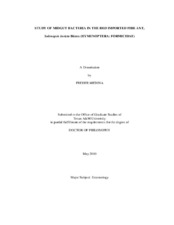| dc.description.abstract | Ants are capable of building close associations with plants, insects, fungi and bacteria. Symbionts can provide essential nutrients to their insect host, however, the development of new molecular tools has allowed the discovery of new microorganisms that manipulate insect reproduction, development and even provide defense against parasitoids and pathogens. In this study we investigated the presence of bacteria inside the Red Imported Fire Ant midgut using molecular tools and transmission electron microscopy. The midgut bacteria were also characterized by their morphology, biochemical activity, and antibiotic resistance profile.
After isolation, culture, and characterization of these bacteria, the molecular analysis revealed ten unique profiles which were identified to at least the genus level, Enterococcus sp./durans, Klebsiella ornithinolytica, Kluyvera cryocrescens, Lactococ-cus garvieae, Pseudomonas aeruginosa, Achromobacter xylosoxidans, Bacillus pumilus, Listeria innucua, Serratia marcescens, and an uncultured bacterium from the Entero-bacteriaceae. New SEM and TEM techniques revealed a possible functional association of endosymbiotic bacteria with the insect host, and it also showed the absence of bacteriocytes in the epithelial cells of the midgut. The PCR results, from the bacteria abundance and distribution studies, showed that Enterococcus sp., Kluyvera cryocres-cens and Lactococcus garvieae are the most abundant species, but they are not consistently found in all sites throughout the southeastern United States.
Kluyvera cryocrescens, Serratia marcescens, and an uncultured bacterium (isolate #38: Enterobacteriaceae) were genetically modified with the plasmid vector pZeoDsRed and successfully reintroduced into fire ant colonies. Strong fluorescence of DsRed was detected up to seven days after introduction. The transformed bacteria can still be rescued after pupal emergence; however most were passed out in the meconium. We further demonstrated that nurses contributed to the spread of the transformed bacteria within the colony by feeding the meconium to naive larvae.
Although the role of midgut bacteria in the fire ant is still unknown, we have no indication that they cause any pathology. Studies emphasizing the role of these bacteria in fire ant physiology are still ongoing. These results are the foundation for a fire ant biological control program using endosymbiotic bacteria as vectors to introduce foreign genes that express proteins with insecticidal properties. | en |


